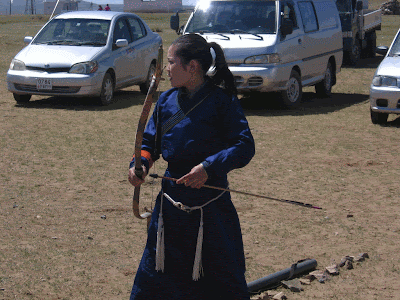Cyrillic
|
нум
|
NomO
|
Transcription
|
num
|
|
IPA
|
[nʊm]
|
|
Layman’s Pronunciation
|
NOOM
|
|
Meaning
|
bow
|
|
In Genghis Khan’s time it was numu.
|
||
Cyrillic
|
сум
|
SomO
|
Transcription
|
sum
|
|
IPA
|
[sʊm]
|
|
Layman’s Pronunciation
|
SOOM
|
|
Meaning
|
arrow, dart, bullet, missile, cursor
|
|
In Genghis Khan’s time it was
numu.
|
||
Нум means “bow.” Сум (a homophone of the word for district)
means “arrow” and “dart,” and by extension also “bullet,” “missile,” and
“cursor.” Together the two form the compound нум сум, “archery.” Archery is also
called сур харвалт or байт харваа.
The bow was the most important
weapon of ancient steppe nomads. Chinggis Khaan’s warriors are credited with
numerous feats that astounded their enemies, such as firing arrows backwards at
approaching armies while they retreated on horseback. Archery skill is still
celebrated in Mongolia every July, although the modern bows, I’m told, are very
different from the bows of 800 years ago. They’re larger, and would be much
less useful on horseback. Naadam archers today compete standing up, but I’d
love to see mounted archery come back.
Personally, archery is one of
the most fascinating things in Mongolia, but unlike Mongolian script, of which
I can say now “Ok, I learned that,” I’ve tried in vain for 2 years to find
someone to teach me archery. No one I know at site practices archery or knows
anyone who does. But at least I was lucky enough that my sum became host
to an archery demonstration back in May, and I got to try it out a little bit.
When the archer takes the bow out of its case (хоромсого),
she must reattach the bowstring (хөвч) to the bow. Next, take an
arrow out of the quiver (саадаг). The Mongolian
archer must nock the arrow (нум сум онилох), or place the little
notch (онь) on the butt of the arrow so it fits on the middle of
the string. She now draws the bow (хөвч татах) as she raises it
to aim at her target. To draw the bow properly, pull the middle of the
bowstring with your thumb and wrap your other fingers in front of the thumb.
The target (бай) is made up of
many pieces of leather called сур. When her aim is certain, she shoots
(сумаар харвах). The arrow flies until
it hits the target (бай онох) - or misses (бай онохгүй).
Or look here:
 |
| A left-handed archer draws and shoots |
You can see many more pictures of our archery exhibition here.
For those who can read Mongolian, these websites have some longer lists of archery
terminology:
- http://www.goldenbridge-forapartment.com/en/mongolia/show/id/271
- http://lhagii_0529.blog.gogo.mn/index.html
